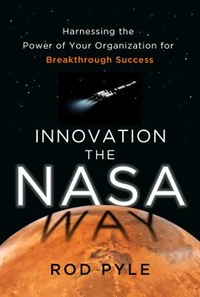Review: Innovation the NASA Wayby Jeff Foust
|
| Given the proper resources, NASA has shown boldness in its five decades of work in space that make most industries pale by comparison,” writes Pyle. |
In Innovation the NASA Way, Pyle mines those five decades of history for examples of innovation. He picks a diverse range of examples, each covered in its own chapter, from NASA’s prehistory (the launch of Explorer 1) to the modern day (Curiosity’s landing on Mars), including both human and robotic missions. For space aficionados, this is all familiar territory, although Pyle livens up the stories with colorful descriptions and anecdotes. One example is the story of an engineer, working late hours at the Johnson Space Center in an effort to save the newly-launched Skylab, finding the center’s gates locked as he tried to leave late one night; “having not seen his home for many days, he lost his patience and climbed the fence,” despite that fence being topped with barbed wire, Pyle writes.
Those anecdotes, and even the specific technical solutions to various challenges, though, aren’t the purpose of this book. Instead, Pyle looks at the processes that enabled those innovations, sifting through those technical solutions for more general lessons learned. In the Skylab example, Pyle notes the challenges of trying to repair the space station, as the first crew of astronauts discovered procedures developed on the ground didn’t work as planned. “Solution: Adapt to the situation, taking some calculated risks in a totally unforgiving environment. Invent procedures as you see fit on site,” he concludes. That’s just one of many such combinations of challenges and solutions, highlighted in text boxes throughout the book; some are specific to the particular challenge, while others seem so basic as to be obvious. Each chapter also includes a bulleted list of challenges at its beginning, and innovations at its end, perhaps for the busy executive, or student, who has time only to skim the book.
The NASA of today, Pyle acknowledges, is different from the one that landed humans on the Moon 45 years ago: “it has grown up (some would assert that it has grown old).” Yet, he argues it’s still an innovative agency, in part because it’s able to harness what he considers to be three key elements of any such organization: creating bold plans, perform daring execution of those plans, and support a passionate workforce. The message of Innovation the NASA Way is that other companies and organizations can enjoy similar success by following those core tenets of innovation. It may even be a good reminder for NASA itself.
